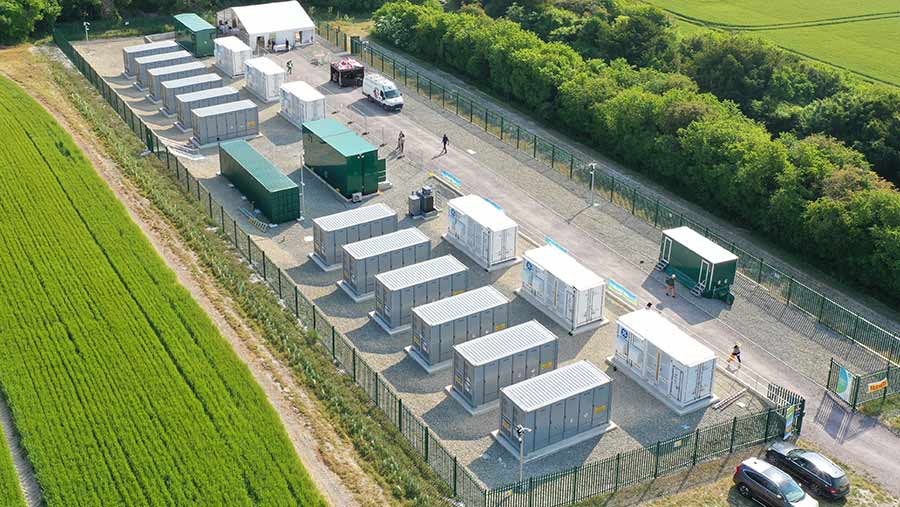Business Clinic: What are the premiums for battery storage?
 © Kevin Milner
© Kevin Milner Whether it’s a legal, tax, insurance, management or land issue, Farmers Weekly’s Business Clinic experts can help.
Alex Ireton, a surveyor with Carter Jonas, sets out some considerations for battery storage projects
Q. We’re considering a 50MW battery storage proposition and would like to know about the lease premiums available in this market and how much the usual milestone premiums are worth; for example on gaining planning permission, lease assigning and so on.
See also: Business Clinic: will SFI options meet my tenancy terms?
A. For readers unfamiliar with this market, we will set out a few different types of premiums. These are a single capital payment in addition to other payments in an agreement, such as rent.
- Exclusivity premium: This comes into play when you are in initial negotiations with a developer, giving them exclusive rights during the negotiation phase.
- Milestone premiums: These premiums are tied to specific milestones in the development process, such as achieving planning permission, on lease entry, or when the project starts to produce or, in this case, store energy (often referred to as energisation). It is important to note that not all premiums apply to every deal and the exact terms vary.
- Assignment premium: This really depends on the wider commercial picture. Factors will include the degree of control the landowner retains over the developer’s ability to assign the option or lease to others. More control typically results in a smaller premium.
Premiums can be structured as a lump sum, a rate per megawatt or even, in rare cases, as a percentage of the project’s overall development value.
Exclusivity premiums will be small as the project risk is still high at that stage.
Milestone premiums should be considered when structuring a battery storage lease, with the reducing risk to the project reflected in their value.
Assignment premiums are difficult to agree, but should be considered if it is likely the project will be assigned and you will have to forge a new relationship with an unknown third party.
Even more difficult to achieve is an assignment premium that is linked to a percentage of development value – a situation that allows for landowners to capitalise on increasing project values over time.
The cake is only so big, though – if you want a big slice at lease entry, there may not be much left for assignment.
It is natural for a developer to come in with a relatively low offer, and some won’t even initially offer premiums.
However, when sites are taken to several developers for tender, they will usually try to distinguish themselves from the competition by offering either higher rents or premiums.
Without more detail on rents, battery duration, project size and so on, it is very difficult to answer what exactly should be paid as a premium.
Deal structure
Each deal is structured differently, each project has a different value, and each developer will have different relationships and requirements with their funders.
Initial conversations to sound out these relationships and what other options the developer has are key to the rest of the negotiation.
Landowners considering battery storage projects need to be absolutely sure that there is some form of financial instrument in place so that a sufficient sum of money is deposited at the right time in the lease to cope with decommissioning.
This is to ensure that you won’t have to bear any of the associated cost of this and that the developer, in all cases, is going to take care of decommissioning.
Batteries are currently very popular because they are broadly supported by policy and existing businesses are showing strong returns.
Demand for batteries should continue as the increased deployment of renewable energy schemes will drive a need for energy storage.
Grid constraint
Securing a grid connection, however, remains the key constraint to having your project move forward. The number of projects under consideration is substantial.
Not all projects will be built out and increasingly connections are not being offered until 2030 onwards.
The market is starting to cool down now because the ability to buy electricity low and sell high, although still strong, is not as astonishingly rewarding as during the past year’s energy fluctuations.
Some developers are being a bit more hard-nosed in their negotiations than they were six months ago. Staying informed about market trends is crucial for successful lease agreements.
In conclusion, the specifics of lease premiums and milestones can vary widely, making it important to tailor agreements to the unique circumstances of each project.
It’s advisable to work closely with experts who specialise in renewable energy to ensure a mutually beneficial arrangement.
Do you have a question for the panel?
Outline your legal, tax, finance, insurance or farm management question in no more than 350 words and Farmers Weekly will put it to a member of the panel. Please give as much information as possible.
Email your question to FW-Businessclinic@markallengroup.com using the subject line “Business Clinic”.
